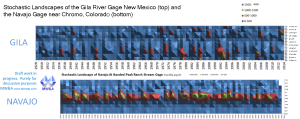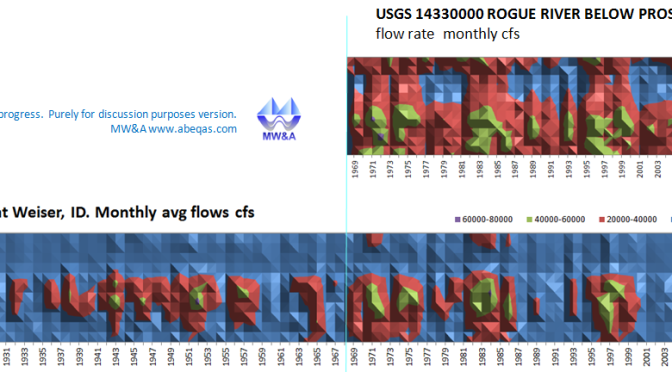A stochastic landscape plot of the Gila River gage record in Southeastern New Mexico has a distinctive ‘dryline’ feature not seen in previous stochastic landscape time series for other US Southwestern streams, so far. The line of low streamflow within the plot parameters used, is clearly evident and associated with early to mid summer.
 The Navajo gage is located deep within the Rocky Mountains a few hundred miles to the north and several thousand feet higher in elevation, compared to the Gila station. Although the Gila watershed includes a snowpack, the impact of that is graphically less evident than for the Navajo. And although the Navajo obviously experiences a summer, there is little graphical registration of a ‘dryline’.
The Navajo gage is located deep within the Rocky Mountains a few hundred miles to the north and several thousand feet higher in elevation, compared to the Gila station. Although the Gila watershed includes a snowpack, the impact of that is graphically less evident than for the Navajo. And although the Navajo obviously experiences a summer, there is little graphical registration of a ‘dryline’.
In spite of these important differences, a previous post documents that both stream gage records express strong correspondence to the PDO, along with apparent contributing influences from other ocean indexes. There appears to be no contradiction. The impacts of local orography, latitude and altitude all appear to work to modulate the PDO dominated signature in a manner consistent with hydrologic expectations.
Please note that as for past stochastic landscapes I have developed, each series is automatically ranged to its full data extent and therefore for absolute readings, each must be examined according to its own legend. For example, the Gila plot blue color covers a range of 0 to 500 cfs, whereas the blue for the Navajo series covers a range of 0 to 200 cfs. I produce these now for their strength at relative comparisons, along with additional proprietary processing my firm utilizes in ongoing hydrologic forecasting.
Finally, any interested reader is invited to study both time series (and those in previous posts) for evidence of a so-called Early Spring. The Early Spring assertion has been applied by numerous researchers to this very region. Moreover for the US Southwest at least, that notion is now embedded in contemporary government climate and weather forecasting content.
For my part, that notion appears to be contradicted by this data and many other hydologic time series in the Western US. Accordingly, MW&A forecasts do not directly utilize the Early Spring notion. This is one of the many reasons that our hydrologic forecasts are continuing to outperform government sponsored forecasts.
 4235total visits,4visits today
4235total visits,4visits today
